A Crane Oiler Dies When Crushed Between the Counterweights and the Rotating Superstructure of a Mobile Crane
California Case Report: 04CA003
Summary
A 64-year-old Hispanic male crane oiler died when he was crushed between the counterweights and the rotating superstructure of a mobile crane. The victim climbed up on the crane while the crane’s superstructure was rotating. The victim did not communicate his intention with the crane operator. The crane cab did not have any mirrors to reflect activity in its rear when rotating. The CA/FACE investigator determined that, in order to prevent future occurrences, employers, as part of their Injury and Illness Prevention Program (IIPP), should:
- Ensure all personnel are clear from the counterweight and superstructure area before rotating the crane.
- Ensure there is constant and clear communication between the crane oiler and the crane operator whenever the crane’s superstructure is in motion.
- Consider installing mirrors or other devices on the crane’s cab to allow the operator to see any action to the rear of the superstructure when rotating.
Introduction
On February 1, 2004, a 64-year-old Hispanic male crane oiler died from injuries he sustained on January 28, 2004, at approximately 9:45 a.m., when he was crushed between the counterweights and superstructure of a rotating mobile crane. The CA/FACE investigator learned of this incident on February 19, 2004, through the Los Angeles County Coroner’s Post Mortem Report. On March 15, 2004, the CA/ FACE investigator and his associate traveled to the business where the victim was employed. The company’s president and co-workers were interviewed and the machine involved in the incident was photographed and inspected.
The employer of the victim was a crane rental company. The company had been in business for 30 years. The company had 18 employees and two were at the job site when the incident occurred. The victim had been employed by the company for nine years. The victim was born in Mexico. He had been in the United States for 45 years and spoke primarily English. The company had a written IIPP that was last updated in 2002. Safety tailgate meetings were held on the job but were not documented. The company did not have a training program. According to the company owner, all employees were union members and were trained and certified competent in their trade by the union before they were hired.
Investigation
The site of the incident was a construction site of a commercial business. The machine involved in the incident was a mobile crane (Exhibit 1) that was hired to move concrete blocks at the construction site. After the crane arrived at the job site, the crane operator and victim did a job site evaluation to determine the amount of counterweights needed to perform the lifts. The adjustments to the counterweights were made using the crane hook. After the proper amount of counterweights were in place, the crane needed to turn around to attach the counter weights to the crane base. The operator and victim made eye contact as they did many times in the past, then the operator turned his attention to the controls of the crane as he began rotating the crane around. The victim, according to the crane operator, would then sit on or stand next to the crane’s right front outrigger and signal the operator once the crane and the counterweights were aligned. As the crane operator swung the crane around, he heard an unfamiliar noise and when he looked to the rear he saw the victim caught between the counterweights and the base of the crane. The operator got out of his cab to check on the victim, then went back to the cab to move the crane off of him. He lifted and carried the victim from the crane and placed him on the ground, then ran to get help.
Paramedics were called and they transported the victim to the hospital where he died two days later as a result of his injuries sustained in this incident. Reconstruction of the incident suggested the victim climbed onto the crane to remove a shackle that was left on top of the counterweights. According to the crane operator the shackle would have interfered with the counterweights’ connection to the superstructure.
Cause of Death
The cause of death, according to the death certificate, was blunt injuries.
Back to Top
Recommendations/Discussion
Recommendation #1: Ensure all personnel are clear from the counterweight and superstructure area before rotating the crane.
Discussion: The crane operator and victim had worked together for several years, and as a result of their working relationship they developed a habit of rotating the crane while the victim was not clear of the superstructure. As the crane rotates, the operator can not see all the action at the back of the crane because of the blind spots. The crane operator should not start rotating the crane without knowing all personnel are clear of the superstructure either by seeing or some other means. Employees also have a responsibility to stay clear of the crane while it is rotating. Safe work practices can be enhanced through programs of task-specific training, supervision, rewards, and progressive disciplinary measures.
Recommendation #2: Ensure there is constant and clear communication between the crane oiler and the crane operator whenever the crane’s superstructure is in motion.
Discussion: The crane operator and victim had worked together on this crane since it was purchased over three years ago. According to the crane operator they always worked well together and did not have to verbally communicate with each other all the time because they just knew what to do at certain times during the crane operation by a simple nod or a glance. In this case, a nod between both parties meant that the crane was going to rotate into position to connect to the counterweights and the victim would assume his usual position as he had done numerous times in the past. This system of communication worked as long as the conditions did not change. When the victim left his usual position and climbed on top of the crane while it was rotating, he failed to communicate his action beforehand to the crane operator. Clear and constant communication could have been maintained through the use of two-way radios or other such devices that are used for signaling purposes.
Recommendation #3: Consider installing mirrors or other devices on the crane’s cab to allow the operator to see any action to the rear of the superstructure when rotating.
Discussion: Most truck mounted cranes do not have mirrors on the crane’s operating cab because the operator’s attention is usually focused on the hook and boom which is always in front of or above the cab and never in the rear. However, when the focus of the operation is not on the hook and boom, then consideration should be given to where the operator’s attention is focused. When rotating the crane for counterweight alignment, it might be beneficial to have mirrors or other devices that allow the operator to see the rear of the crane. This would allow the operator to take immediate evasive action when necessary.
Exhibits
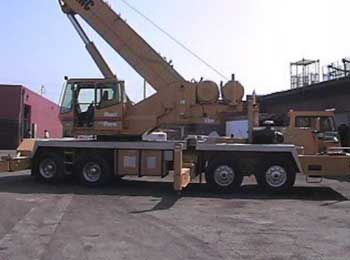 |
|
Exhibit #1. The mobile crane involved in the incident.
|
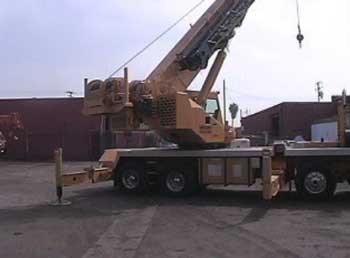 |
|
Exhibit #2. The truck-mounted crane rotating into position, depicting the blind spot for the operator.
|
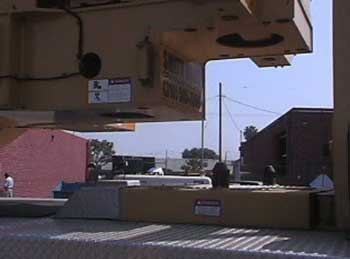 |
|
Exhibit #3. The base where counterweights are placed in order to be attached to the crane.
|
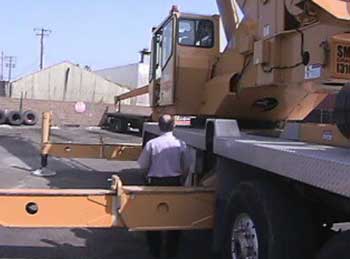 |
|
Exhibit #4. A simulated picture depicting the victim’s position while the crane rotated into position.
|
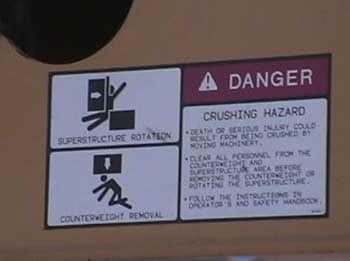 |
|
Exhibit #5. A picture of the safety placard on the crane.
|
References
- California Code of Regulations, Vol. 9, Title 8, Sections 4993 (c)
- Operator’s Safety Handbook, Grove Cranes, Supplement, 1997
California Fatality Assessment and Control Evaluation (FACE) Project
The California Department of Health Services, in cooperation with the California Public Health Institute, and the National Institute for Occupational Safety and Health (NIOSH), conducts investigations on work-related fatalities. The goal of this program, known as the California Fatality Assessment and Control Evaluation (CA/FACE), is to prevent fatal work injuries in the future. CA/FACE aims to achieve this goal by studying the work environment, the worker, the task the worker was performing, the tools the worker was using, the energy exchange resulting in fatal injury, and the role of management in controlling how these factors interact. NIOSH funded, state-based FACE programs include: Alaska, California, Iowa, Kentucky, Massachusetts, Michigan, Minnesota, Nebraska, New Jersey, New York, Oklahoma, Oregon, Washington, West Virginia, and Wisconsin.
To contact California State FACE program personnel regarding State-based FACE reports, please use information listed on the Contact Sheet on the NIOSH FACE website. Please contact In-house FACE program personnel regarding In-house FACE reports and to gain assistance when State-FACE program personnel cannot be reached.
